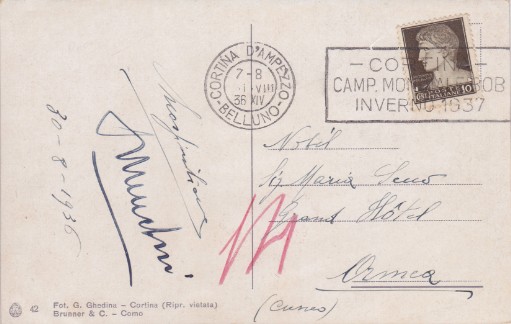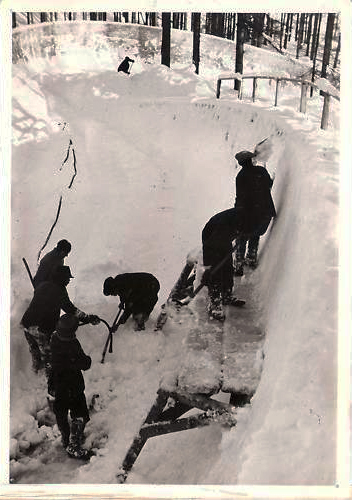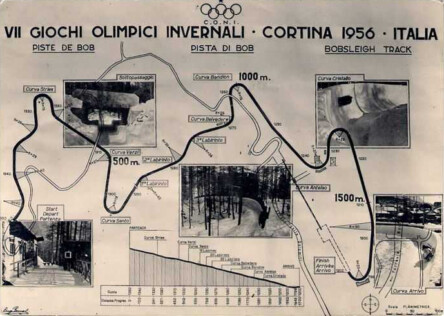Pista del Bob
Lo sport del bobsleigh ha vecchie e gloriose tradizioni a Cortina, che ne fu la culla in Italia. Vi venne introdotto nel 1905-1906 e praticato inizialmente solo su strada, sul tratto Pocol-Cortina della strada delle Dolomiti. Nel 1911 si tentò di costruire una pista artificiale nei dintorni del centro di Cortina, della lunghezza di poche centinaia di metri. L'esperimento non ebbe esito favorevole, anche per insufficienza di mezzi disponibili; e si continuò così a servirsi della strada di Pocol quale campo di gara.


Solo nel 1923 si decise di costruire una vera pista da bob; venne realizzata nei pressi del villaggio di Ronco, a breve distanza dal centro di Cortina, con un tracciato della lunghezza di m. 1200, che ha termine sulla Strada delle Dolomiti. Venne apprestato un apposito acquedotto; le curve furono costruite in terra battuta, ricoperta di zolle. I profili di queste curve erano piuttosto approssimativi, comunque sufficienti per le velocità modeste di allora. Nel 1928 la pista venne per la prima volta utilizzata per una manifestazione a carattere internazionale: i campionati mondiali universitari. Da allora il numero delle gare nazionali ed internazionali aumentò continuamente, e con esse si accrebbe e consolidò la fama dell'impianto. Nel 1936 si procedette ad un completo rimodernamento della pista, sull'esempio di St. Moritz e di Garmisch. L'arrivo venne spostato a valle verso il torrente, in modo che lo sviluppo lineare raggiungesse i 1500 m. con 15 curve ed un dislivello di 152 metri. Nello stesso inverno 1936-37 l'impianto venne sottoposto ad una severa prova con l'organizzazione dei campionati del mondo di bob a 2, prova che ebbe un esito felice. Dopo altri due anni di perfezionamenti, il campionato del mondo 1939 di bob a 4 segnò un pieno successo. Da allora l'impianto cortinese è considerato fra i migliori del mondo. Nel 1948 i lavori di restauro e di messa a punto vennero ripresi sotto l'egida del C.O.N.I. Tutte le curve vennero rifatte, ed in particolare la «esse», con speciale cura per i profili. Venne costruita la grande curva di arrivo, portando lo sviluppo lineare dell'impianto a 1700 m., con 16 curve e 152 m. di dislivello.

Quando, nell'aprile 1949, i Giochi olimpici invernali 1956 vennero assegnati a Cortina, il CONI assunse in proprio la completa ricostruzione e valorizzazione della pista, con larghezza di vedute ed ingenti mezzi finanziari, anche per quanto riguarda le attrezzature complementari: tribune, segnalazioni, servizi di cronometraggio, tabelloni, ecc. Nel 1950 i campionati del mondo di bob a 2 ed a 4 si svolsero a Cortina, con esito brillante. Durante il Congresso della Federazione Internazionale di bob, ad Oslo, nel corso dei Giochi Invernali 1952, Cortina ebbe nuovamente l'incarico di organizzare i «Mondiali 1954». Per l'occasione, anche per evitare incidenti come quello capitato durante i campionati italiani, quando durante gli allenamenti un bob uscito fuori pista si abbattè sulla cabina dei cronometristi, tutti i dettagli dell'organizzazione vennero particolarmente curati. Equipaggi e pubblico ammirarono i grandi tabelloni, con la indicazione delle squadre e dei tempi, come pure un grande tabellone luminoso, riproducente l'andamento del tracciato della pista. Fu una prova generale riuscita per le gare olimpiche di due anni dopo.


